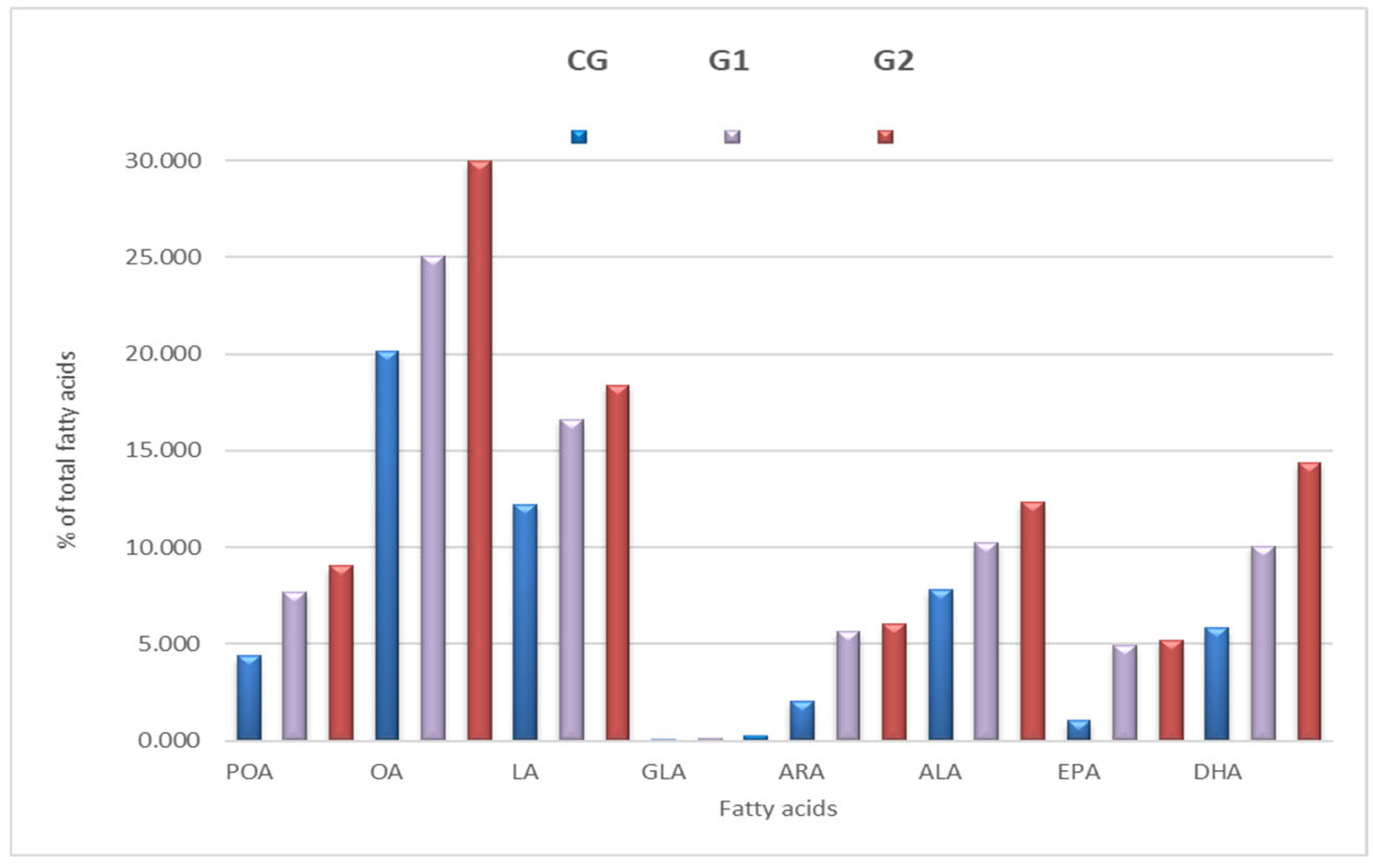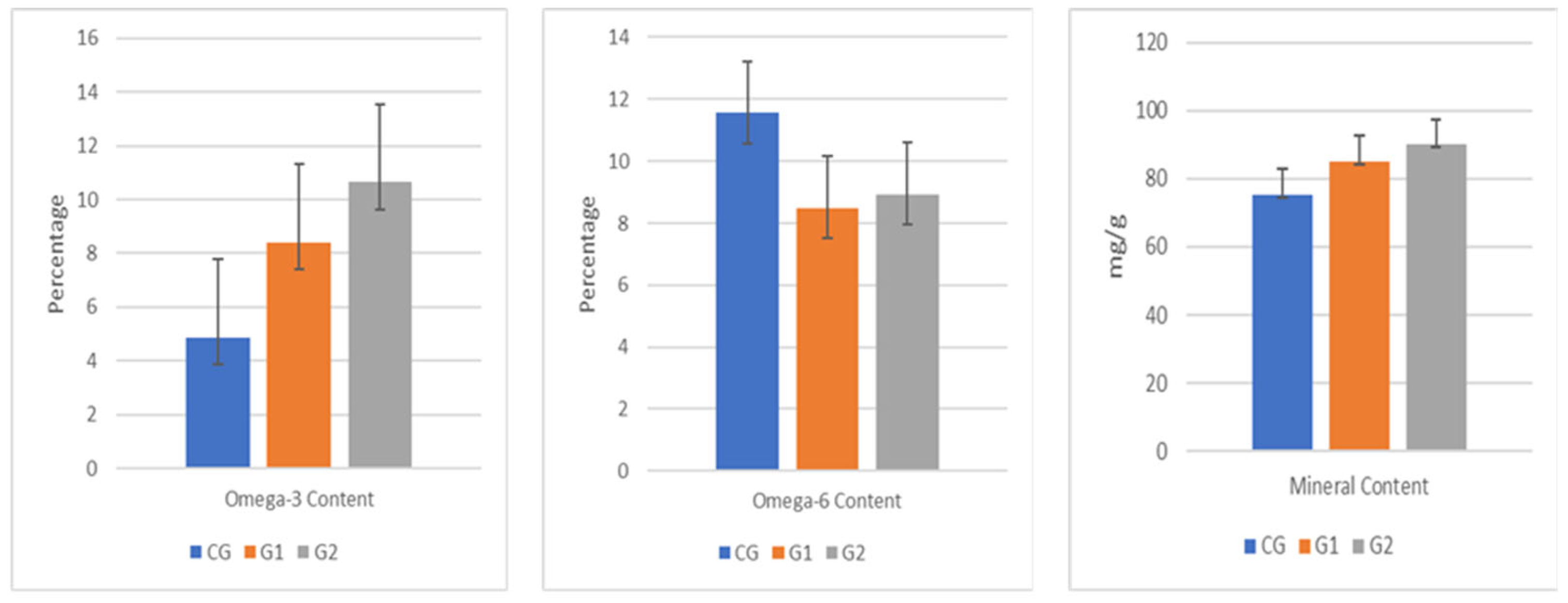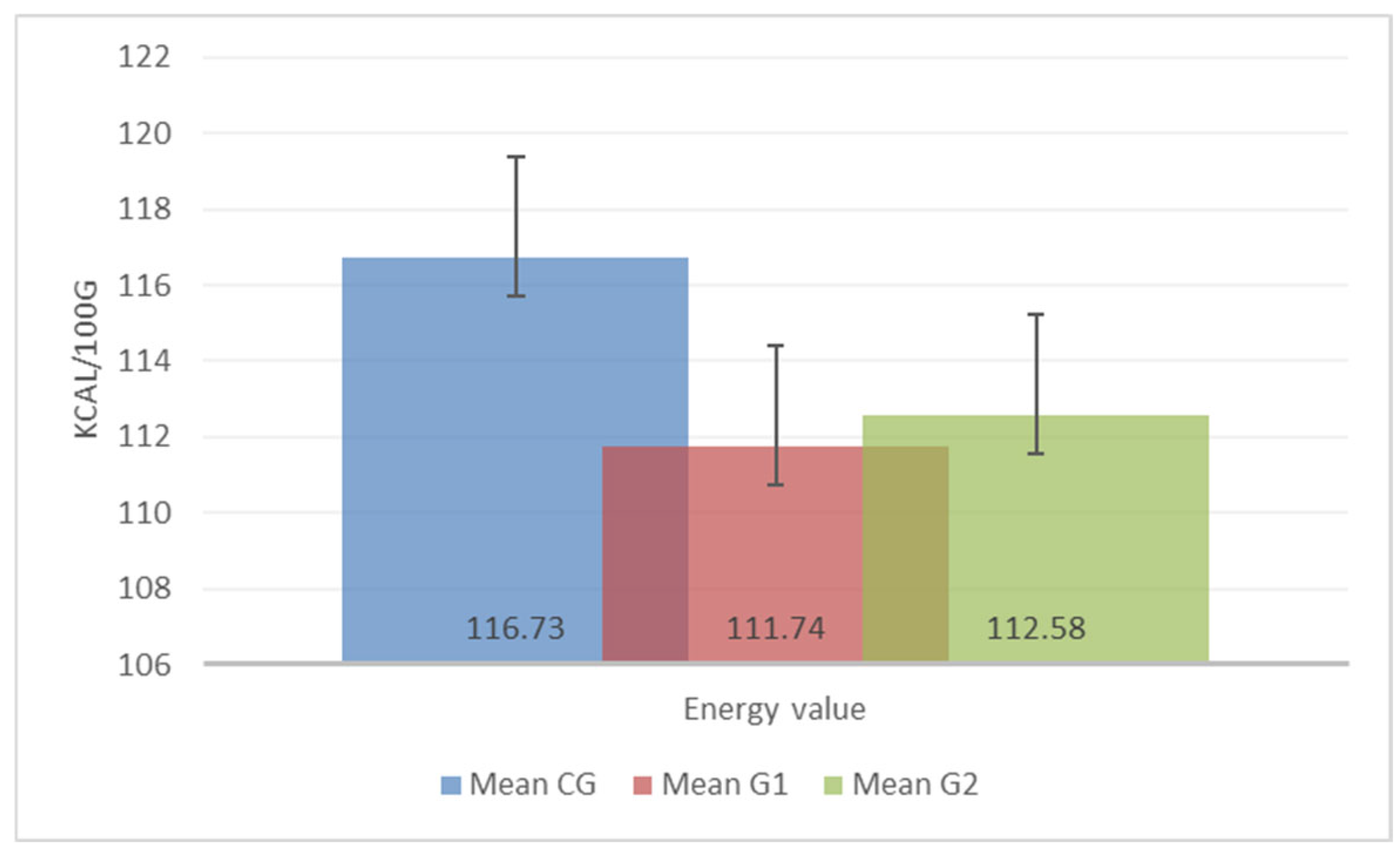Improving the Nutritional Properties of Rabbit Meat Through Dietary Supplementation with Linseed Meal, Fodder Yeast, and Selenium Yeast
Abstract
1. Introduction
2. Materials and Methods
2.1. Experimental Conditions
2.2. Feeding Diets
2.3. Chemical Analysis of Feeds
2.4. Chemical Composition Analysis of Meat
2.5. Fatty Acids Analysis of Meat
2.6. Meat Mineral Content Analysis
2.7. Statistical Analysis of Data
3. Results
3.1. Chemical Analysis of Feeds
3.2. Meat Crude Chemical Composition Analysis
3.3. Meat Fatty Acids Analysis
3.4. Meat Mineral Content Analysis
4. Discussion
5. Conclusions
Author Contributions
Funding
Institutional Review Board Statement
Informed Consent Statement
Data Availability Statement
Conflicts of Interest
References
- Capra, G.; Martínez, R.; Fradiletti, F.; Cozzano, S.; Repiso, L.; Márquez, R.; Ibáñez, F. Meat quality of rabbits reared with two different feeding strategies: With or without fresh alfalfa ad libitum. World Rabbit Sci. 2013, 21, 23–32. [Google Scholar] [CrossRef]
- Dalle Zotte, A. Dietary advantages: Rabbit must tame consumers. Viandes Prod. Carnés 2004, 23, 161–167. [Google Scholar]
- Hernandez, P.; Gondret, F. Rabbit meat quality. In Recent Advances in Rabbit Sciences; COST Action; COST: Brussels, Belgium, 2006. [Google Scholar]
- Nistor, E.; Bampidis, V.; Păcală, N.; Pentea, M.; Tozer, J.; Prundeanu, H. Nutrient content of rabbit meat as compared to chicken, beef and pork meat. J. Anim. Prod. Adv. 2013, 3, 172–176. [Google Scholar] [CrossRef]
- Dalle Zotte, A. Main factors influencing the rabbit carcass and meat quality. In Proceedings of the 7th World Rabbit Congress, Valencia, Spain, 4–7 July 2000. [Google Scholar]
- Lombardi-Boccia, G.; Lanzi, S.; Aguzzi, A. Aspects of meat quality: Trace elements and B vitamins in raw and cooked meats. J. Food Compos. Anal. 2005, 18, 39–46. [Google Scholar] [CrossRef]
- Maertens, L.; Coudert, P. Recent Advances in Rabbit Sciences; COST Action; COST: Brussels, Belgium, 2006. [Google Scholar]
- de Blas, C.; Wiseman, J. Nutrition of the Rabbit, 2nd ed.; CABI: Wallingford, UK, 2020; ISBN 978-1-78924-127-3. [Google Scholar]
- Petrescu, D.C.; Petrescu-Mag, R.M. Consumer behaviour related to rabbit meat as functional food. World Rabbit Sci. 2018, 26, 321–333. [Google Scholar] [CrossRef]
- Blaga, B.C.; Burny, P. Rabbit production and rabbit market in Romania: The most frequent breeds, half-breeds and their characterization. Rabbit Genet. 2014, 4, 1–14. [Google Scholar]
- McNitt, J.; Patton, N.; Lukefahr, S.; Cheeke, P.R. Rabbit Production, 9th ed.; CAB International: Wallingford, UK, 2013. [Google Scholar]
- Siudak, Z.; Pałka, S. Rabbit meat as functional food. Rocz. Nauk. Zootech. 2022, 49, 127–139. [Google Scholar]
- Corpet, D.E. Red meat and colon cancer: Should we become vegetarians, or can we make meat safer? Meat Sci. 2011, 89, 310–316. [Google Scholar] [CrossRef]
- Pla, M.; Pascual, M.; Ariño, B. Protein, fat and moisture content of retail cuts of rabbit meat evaluated with the NIRS methodology. World Rabbit Sci. 2004, 12, 149–158. [Google Scholar] [CrossRef][Green Version]
- Mensah, A.; Adams, F.; Stephen, P.; Afriyie, O.S. Prospects for commercialization of rabbit production in Africa: Empirical evidence from Ghana. Clean. Circ. Bioeconomy 2024, 1, 100–122. [Google Scholar] [CrossRef]
- Hernández, P.; Xicato, G.; Trocino, A.; Lukefahr, S. Enhancement of nutritional quality and safety in rabbit meat. Agric. Food Sci. 2008, 1, 1287–1299. [Google Scholar]
- Bordignon, F.; Trocino, A.; Marín García, P.J.; Larsen, T.; Zardinoni, G.; Molin, M.; Birolo, M.; Stevanato, P.; Xiccato, G. Chlorella and vegetable oil inclusion in diets for growing rabbits: Effects on growth, digestibility, plasma metabolites, and caecal fermentations and microbiota. Animal 2024, 18, 101365. [Google Scholar] [CrossRef] [PubMed]
- Agradi, S.; Sulce, M.; Menchetti, L.; Vigo, D.; Castrica, M.; Barbato, O.; Andoni, E.; Quattrone, A.; Munga, A.; Marongiu, M.L.; et al. Dietary supplementation with n-3 polyunsaturated fatty acids: Effects on reproductive and productive performance and meat quality in rabbit breeding. Anim. Nutr. 2023, 14, 70–78. [Google Scholar] [CrossRef] [PubMed]
- Agradi, S.; Draghi, S.; Cotozzolo, E.; Barbato, O.; Castrica, M.; Quattrone, A.; Sulce, M.; Vigo, D.; Menchetti, L.; Ceccarini, M.R.; et al. Goji berries supplementation in the diet of rabbits and other livestock animals: A mini-review of the current knowledge. Front. Vet. Sci. 2021, 8, 823589. [Google Scholar] [CrossRef]
- Bayrak, A.; Kiralan, M.; Ipek, A.; Arslan, N.; Cosge, B.; Khawar, K.M. Fatty acid compositions of linseed (Linum usitatissimum L.) genotypes of different origin cultivated in Turkey. Biotechnol. Biotechnol. Equip. 2010, 24, 1836–1842. [Google Scholar] [CrossRef]
- Ramcharitar, A.; Badrie, N.; Mattfeldt-Beman, M.; Matsuo, H.; Ridley, C. Consumer acceptability of muffins with flaxseed (Linum usitatissimum). J. Food Sci. 2005, 70, S504–S507. [Google Scholar] [CrossRef]
- Wirkijowska, A.; Zarzycki, P.; Sobota, A.; Nawrocka, A.; Blicharz-Kania, A.; Andrejko, D. The possibility of using by-products from the flaxseed industry for functional bread production. LWT 2020, 118, 108860. [Google Scholar] [CrossRef]
- Gao, Y.; Liu, T.; Su, C.; Li, Q.; Yu, X. Fortification of Chinese steamed bread with flaxseed flour and evaluation of its physicochemical and sensory properties. Food Chem. X 2022, 13, 100267. [Google Scholar] [CrossRef]
- Patterson, R.; Rogiewicz, A.; Kiarie, E.G.; Slominski, B.A. Yeast derivatives as a source of bioactive components in animal nutrition: A brief review. Front. Vet. Sci. 2023, 9, 1067383. [Google Scholar] [CrossRef]
- EFSA Panel on Additives and Products or Substances used in Animal Feed (FEEDAP); Rychen, G.; Aquilina, G.; Azimonti, G.; Bampidis, V.; Bastos, M.d.L.; Bories, G.; Chesson, A.; Cocconcelli, P.S.; Flachowsky, G.; et al. Safety and efficacy of selenium-enriched yeast (Saccharomyces cerevisiae CNCM I-3399) for all animal species. EFSA J. 2017, 15, e04937. [Google Scholar] [CrossRef][Green Version]
- Martiniano, S.E.; Fernandes, L.A.; Alba, E.M.; Philippini, R.R.; Tabuchi, S.C.T.; Kieliszek, M.; dos Santos, J.C.; da Silva, S.S. A new approach for the production of selenium-enriched and probiotic yeast biomass from agro-industrial by-products in a stirred-tank bioreactor. Metabolites 2020, 10, 508. [Google Scholar] [CrossRef] [PubMed]
- EFSA Panel. Scientific opinion on the use of selenium-enriched yeast as a source for selenium added for nutritional purposes in foods for particular nutritional uses and food supplements. EFSA J. 2008, 6, 766. Available online: https://www.efsa.europa.eu/en/efsajournal/pub/766 (accessed on 28 April 2025).
- Lu, J.; Qu, L.; Ma, M.; Li, Y.F.; Wang, X.G.; Yang, Z.; Wang, K. Efficacy evaluation of selenium-enriched yeast in laying hens: Effects on performance, egg quality, organ development, and selenium deposition. Poult. Sci. 2020, 99, 6267–6277. [Google Scholar] [CrossRef] [PubMed]
- Council Directive 98/58/EC of 20 July 1998 concerning the protection of animals kept for farming purposes. Official Journal European Communities. 1998. Available online: https://eur-lex.europa.eu/eli/dir/1998/58/oj (accessed on 28 April 2025).
- European Parliament. P8_TA(2017)0077-Minimum standards for the protection of farmed rabbits. Official Journal European Union. 2017. Available online: https://lege5.ro/en/Gratuit/gm3tmmbqha2a (accessed on 28 April 2025).
- EFSA Panel on Animal Health and Welfare (AHAW); Saxmose Nielsen, S.; Alvarez, J.; Bicout, D.J.; Calistri, P.; Depner, K.; Drewe, J.A.; Garin-Bastuji, B.; Rojas, J.L.G.; Schmidt, C.G.; et al. Health and welfare of rabbits farmed in different production systems. EFSA J. 2020, 18, e05944. [Google Scholar]
- Council Regulation (EC) No 1099/2009 of 24 September 2009 on the protection of animals at the time of killing. Official Journal European Union. 2009. Available online: https://eur-lex.europa.eu/legal-content/EN/TXT/?uri=CELEX:32009R1099 (accessed on 28 April 2025).
- ANSVSA. Slaughter centers for birds and rabbits at the level of sanitary and veterinary registered farms will be able to continue their activity after 31 December 2020. ANSVSA Off. Announc. 2020. Available online: https://www.ansvsa.ro/ (accessed on 28 April 2025).
- Blasco, A.; Ouhayoun, J. Harmonization of criteria and terminology in rabbit meat research: Revised proposal. World Rabbit Sci. 1996, 4, 93–99. [Google Scholar] [CrossRef]
- National Research Council. Nutrient Requirements of Rabbits, 2nd ed.; National Academies Press: Washington, DC, USA, 1977. [Google Scholar]
- Mayer, J. Nutrition of rabbits. In MSD Veterinary Manual; Merck & Co., Inc.: Rahway, NJ, USA, 2021. [Google Scholar]
- Hypericum Impex. Tratamente și Remedii Naturiste 100% Naturale. Available online: https://hypericumimpex.ro/ (accessed on 28 April 2025).
- AOAC International. Official Methods of Analysis, 22nd ed.; AOAC International: Rockville, MD, USA, 2023. [Google Scholar]
- FAO Council. Calculation of the Energy Content of Foods: Energy Conversion Factors. Available online: https://www.fao.org/4/Y5022E/y5022e04.htm (accessed on 28 April 2025).
- Poșta, D.S.; Radulov, I.; Cocan, I.; Berbecea, A.A.; Alexa, E.; Hotea, I.; Iordănescu, O.A.; Băla, M.; Cântar, I.C.; Rózsa, S.; et al. Hazelnuts (Corylus avellana L.) from spontaneous flora of western Romania: A source of nutrients for locals. Agronomy 2022, 12, 214. [Google Scholar] [CrossRef]
- Prates, J.A.M. Enhancing meat quality and nutritional value in monogastric livestock using sustainable novel feed ingredients. Foods 2025, 14, 146. [Google Scholar] [CrossRef]
- Fehri, N.E.; Contò, M.; Castrica, M.; Quattrone, A.; Renzi, G.; Di Giovanni, S.; Agradi, S.; Vigo, D.; Brecchia, G.; Menchetti, L.; et al. Effects of diets containing extruded linseed and Padina pavonica algae on meat rabbit: Carcass performance and meat quality. Foods 2025, 14, 274. [Google Scholar] [CrossRef]
- El-Gindy, Y.M. The impact of enriching heat-stressed rabbit diets with flaxseed oil with/without allicin, lycopene, or punicalagin on antioxidative status and meat omega-3. BMC Vet. Res. 2025, 21, 187. [Google Scholar] [CrossRef]
- Czauderna, M.; Białek, M.; Białek, A.; Karpińska, M. Diet supplemented with lycopene and selenized yeast changes fatty acids in liver and muscle of rabbits. Livest. Sci. 2021, 250, 104598. [Google Scholar] [CrossRef]
- Tariq, M.; Khan, M.; Sameen, A.; Mehr-un-Nisa. Enrichment of flaxseed for developing functional rabbit meat. Sarhad J. Agric. 2015, 31, 70–74. [Google Scholar]
- Kimsé, M.; Bayourthe, C.; Monteils, V.; Fortun-Lamothe, L.; Cauquil, L.; Combes, S.; Gidenne, T. Live yeast stability in rabbit digestive tract: Consequences on cecal ecosystem, digestion, growth and digestive health. Anim. Feed. Sci. Technol. 2012, 173, 235–243. [Google Scholar] [CrossRef]
- Dalle Zotte, A.; Cullere, M.; Martins, C.; Alves, S.P.; Freire, J.P.B.; Falcão-e-Cunha, L.; Bessa, R.J. Incorporation of black soldier fly larvae fat or extruded linseed in diets of growing rabbits and their effects on meat quality traits. Meat Sci. 2018, 146, 50–58. [Google Scholar] [CrossRef]
- Bianchi, M.; Petracci, M.; Cavani, C. The influence of linseed on rabbit meat quality. World Rabbit Sci. 2009, 17, 97–107. [Google Scholar] [CrossRef][Green Version]
- Tariq Rizwan, M.; Issa Khan, M.; Ahmad, Z.; Ahmed, S.; Sameen, A.; Sameem Javed, M. Development of healthier rabbit meat by supplementation of linseed in the feed and its impact on human blood lipid profile. J. Food Process. Preserv. 2017, 41, e13194. [Google Scholar] [CrossRef]
- Mattioli, S.; Castellini, C.; Mancini, S.; Roscini, V.; Cartoni Mancinelli, A.; Cotozzolo, E.; Pauselli, M.; Dal Bosco, A. Effect of trub and/or linseed dietary supplementation on oxidative status and meat quality in rabbits. Meat Sci. 2020, 163, 108061. [Google Scholar] [CrossRef]
- Marounek, M.; Dokoupilová, A.; Volek, Z.; Hoza, I. Quality of meat and selenium content in tissues of rabbits fed diets supplemented with sodium selenite, selenized yeast and selenized algae. World Rabbit Sci. 2009, 17, 207–212. [Google Scholar] [CrossRef][Green Version]
- Abdel-Khalek, A.M.; Rabie, T.; Kamal, M. Effect of antioxidant and tannin supplementation on growing rabbit performance during summer season. In Proceedings of the 11th World Rabbit Congress, Qingdao, China, 15–18 June 2016; pp. 15–18. [Google Scholar]
- dos Santos, J.J.A.; Pascoal, L.A.F.; Grisi, C.V.B.; Santos, V.C.; de Santana Neto, D.C.; Jordão Filho, J.; Herminio, M.P.F.; Dantas, A.F. Soybean oil and selenium yeast levels in rabbit diet: Performance and meat oxidative stability. Livest. Sci. 2022, 263, 105021. [Google Scholar] [CrossRef]
- Rotolo, L.; Gai, F.; Peiretti, P.G.; Ortoffi, M.; Zoccarato, I.; Gasco, L. Live yeast supplementation in fattening rabbit diets: Effects on performance and meat quality. Livest. Sci. 2014, 162, 178–184. [Google Scholar] [CrossRef]
- Tag El Din, N. Effect of dry live yeast inclusion in fattening rabbit diets on productive performance and digestibility of nutrients. Egypt. J. Rabbit. Sci. 2019, 29, 219–233. [Google Scholar] [CrossRef]




| Feed/Analysis | DM% | M% | CP% | EE% | CF% | NFE% | ME kcal/kg |
|---|---|---|---|---|---|---|---|
| Basic feed/alfalfa | 89.76 | 10.24 | 15.31 | 5.88 | 18.38 | 64.42 | 3703.6 |
| S1 for G1 | 85.99 | 14.01 | 22.25 | 7.08 | 24.40 | 31.74 | 3473.2 |
| S2 for G2 | 84.54 | 15.46 | 17.42 | 10.86 | 28.38 | 24.20 | 3756.6 |
| Ground corn | 85.68 | 14.32 | 7.04 | 2.3 | 3.50 | 73.06 | 3405.4 |
| Linseed meal | 91.49 | 8.51 | 25.62 | 15.76 | 9.29 | 46.99 | 4318.8 |
| Fodder yeast | 91.18 | 8.82 | 46.69 | 1.22 | 5.60 | 39.32 | 3541.2 |
| PM (linseed meal + selenium yeast) | 91.25 | 8.75 | 19.9 | 21.87 | 30.55 | 15.85 | 4613.1 |
| Fatty Acids Analysed | Mean CG * ± SD | Mean G1 * ± SD | Mean G2 * ± SD | p-Value |
|---|---|---|---|---|
| Saturated fatty acids | ||||
| Myristic acid C14:0 | 2.075 ± 0.37 | 5.283 ± 0.57 | 4.531 ± 0.62 | 7.7 × 10−20 |
| Palmitic acid C16:0 | 25.783 ± 1.04 | 28.932 ± 0.74 | 35.381 ± 0.88 | 5.0 × 10−29 |
| Margaric acid C17:0 | 0.447 ± 0.08 | 0.841 ± 0.12 | 0.624 ± 0.26 | 7.1 × 10−07 |
| Stearic acid C18:0 | 5.947 ± 0.69 | 8.282 ± 0.48 | 10.773 ± 0.96 | 1.8 × 10−20 |
| Arachidic acid C20:0 | 0.11 ± 0.06 | 1.911 ± 0.25 | 0.396 ± 0.12 | 1.5 × 10−30 |
| Unsaturated fatty acids | ||||
| Palmitoleic acid C16:1 omega 7 | 4.393 ± 0.39 | 7.682 ± 0.38 | 9.042 ± 0.29 | 8.5 × 10−33 |
| C18:1 oleic acid, omega 9 | 20.148 ± 0.46 | 25.066 ± 0.51 | 29.976 ± 0.64 | 4.8 × 10−38 |
| Linoleic acid C18:2, omega 6 | 12.213 ± 0.69 | 16.632 ± 0.89 | 18.382 ± 1.15 | 4.0 × 10−21 |
| Gamma linolenic acid C18:3, omega 6 | 0.070 ± 0.01 | 0.112 ± 0.03 | 0.237 ± 0.05 | 1.6 × 10−16 |
| Arachidonic acid C 20:4, omega 6 | 2.044 ± 0.22 | 5.673 ± 0.81 | 6.014 ± 1.00 | 1.4 × 10−18 |
| Alpha linolenic acid C18:3, omega 3 | 7.792 ± 0.78 | 10.216 ± 0.69 | 12.326 ± 0.57 | 1.1 × 10−20 |
| Eicosapentaenoic acid C 20:5, omega 3 | 1.024 ± 0.42 | 4.948 ± 0.54 | 5.211 ± 0.41 | 7.2 × 10−28 |
| Docosahexaenoic acid C 22:6, omega 3 | 5.844 ± 0.46 | 10.072 ± 0.60 | 14.391 ± 0.85 | 3.4 × 10−32 |
| Minerals (ppm) | Mean CG ± SD | Mean G1 ± SD | Mean G2 ± SD | p-Value |
|---|---|---|---|---|
| Ca | 16,014.67 ± 103.05 | 19,108.48 ± 697.49 | 22,132.50 ± 506.13 | 5.43 × 10−31 |
| Mg | 17,079.34 ± 925.78 | 20,008.90 ± 597.34 | 23,017.69 ± 609.17 | 4.60 × 10−24 |
| P | 215,271.67 ± 739.18 | 259,416.36 ± 8036.55 | 287,322.01 ± 3785.62 | 1.48 × 10−33 |
| K | 349,148.33 ± 1252.28 | 377,426.27 ± 4024.00 | 382,655.16 ± 6573.08 | 1.05 × 10−23 |
| Fe | 3081.33 ± 74.76 | 2783.54 ± 94.38 | 2817.11 ± 78.61 | 8.46 × 10−13 |
| Zn | 2914.67 ± 82.78 | 2804.24 ± 88.35 | 2838.95 ± 133.58 | 0.0181 |
| Cu | 172.67 ± 12.10 | 181.10 ± 5.00 | 182.72 ± 6.40 | 0.0044 |
| Mn | 29.67 ± 0.80 | 28.33 ± 1.29 | 28.74 ± 1.55 | 0.0172 |
Disclaimer/Publisher’s Note: The statements, opinions and data contained in all publications are solely those of the individual author(s) and contributor(s) and not of MDPI and/or the editor(s). MDPI and/or the editor(s) disclaim responsibility for any injury to people or property resulting from any ideas, methods, instructions or products referred to in the content. |
© 2025 by the authors. Licensee MDPI, Basel, Switzerland. This article is an open access article distributed under the terms and conditions of the Creative Commons Attribution (CC BY) license (https://creativecommons.org/licenses/by/4.0/).
Share and Cite
Plotuna, A.-M.; Hotea, I.; Tîrziu, E. Improving the Nutritional Properties of Rabbit Meat Through Dietary Supplementation with Linseed Meal, Fodder Yeast, and Selenium Yeast. Appl. Sci. 2025, 15, 5427. https://doi.org/10.3390/app15105427
Plotuna A-M, Hotea I, Tîrziu E. Improving the Nutritional Properties of Rabbit Meat Through Dietary Supplementation with Linseed Meal, Fodder Yeast, and Selenium Yeast. Applied Sciences. 2025; 15(10):5427. https://doi.org/10.3390/app15105427
Chicago/Turabian StylePlotuna, Ana-Maria, Ionela Hotea, and Emil Tîrziu. 2025. "Improving the Nutritional Properties of Rabbit Meat Through Dietary Supplementation with Linseed Meal, Fodder Yeast, and Selenium Yeast" Applied Sciences 15, no. 10: 5427. https://doi.org/10.3390/app15105427
APA StylePlotuna, A.-M., Hotea, I., & Tîrziu, E. (2025). Improving the Nutritional Properties of Rabbit Meat Through Dietary Supplementation with Linseed Meal, Fodder Yeast, and Selenium Yeast. Applied Sciences, 15(10), 5427. https://doi.org/10.3390/app15105427








